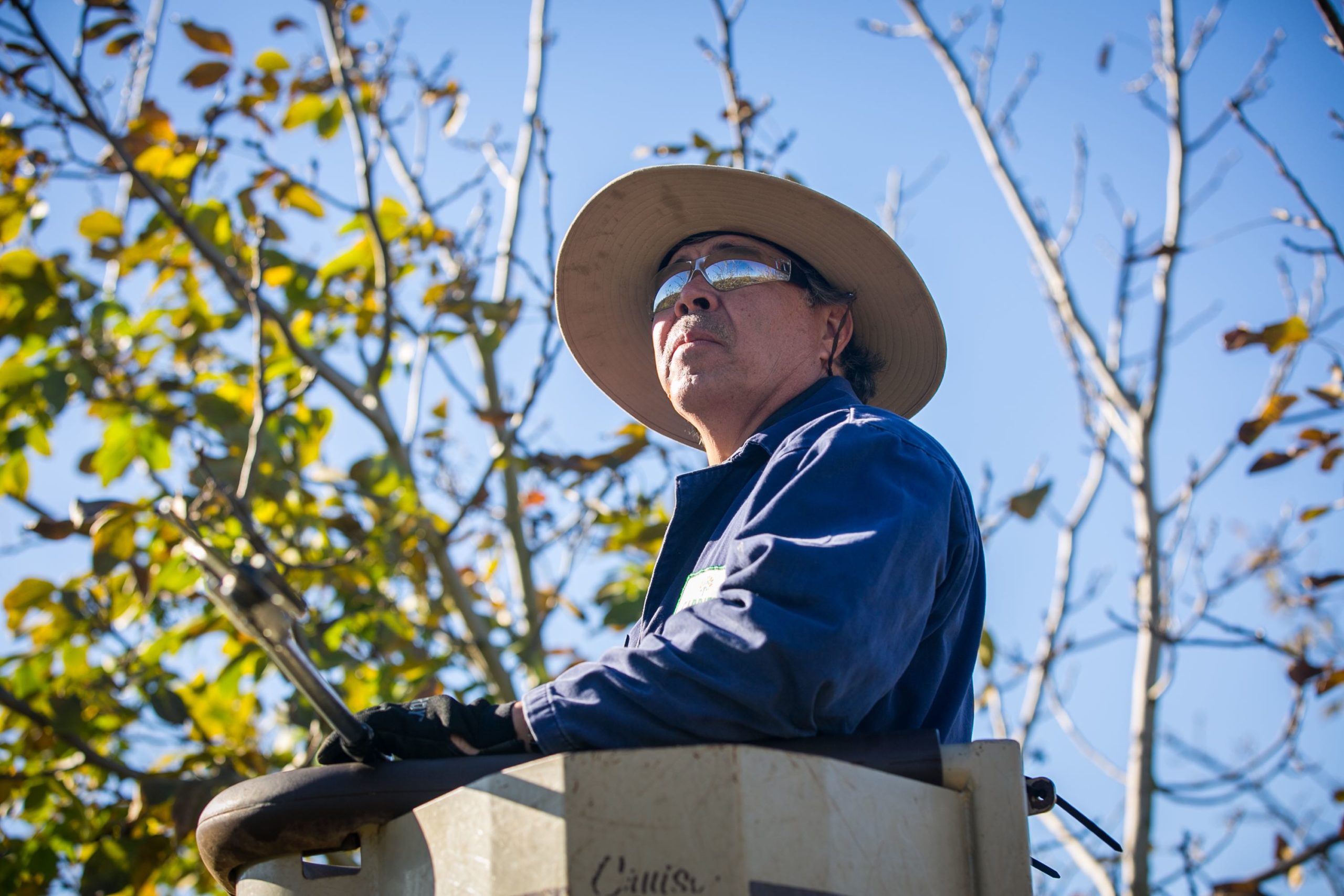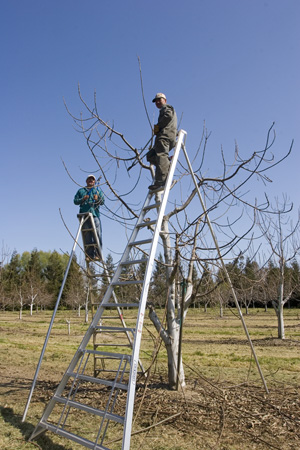
The winter months for permanent crop growers requires important maintenance and care in the orchards and vineyards. Pruning and thinning are commonplace, as are easily avoidable injuries. Before sending crews out to tend to this important work, remember to provide refresher training on ladder and hand-tool safety, along with the importance of using proper personal protective equipment, especially eye-protection.
Ladder Safety
Ladders are an integral part of upkeep in an orchard or vineyard and are easy to overlook when it comes to safe use and maintenance. The California Code of Regulations, Title 8, Section 3276 specifically addresses the proper and safe use of ladders, as well as an employers’ responsibility to ensure this important piece of equipment is cared for and maintained. The standard addresses the following:
- Maintenance: the importance of keeping the ladder in good condition at all times.
- Inspection: ensure that the ladder is looked at by a qualified individual for visible defects and that those inspections happen no less than on a monthly basis.
- Damaged ladders: are removed from service for repair or destruction, while ladders with broken or missing steps, rungs, cleats, safety feet, side rails or other defects shall not be used.
- Proper and frequent cleaning: ladders are free of oil, grease or other slippery, hazardous materials.
- Wooden ladders shall not be painted.
- Ladders shall not be loaded beyond their noted weight rating.
- Ladders must be placed on secure and level footing, not on boxes, barrels or other unstable surfaces. In addition, they are not to be used on ice, snow or slippery surfaces.
It is the employers responsibility to provide workers training in the proper use of a ladder and that training must review the importance of using a ladder safely, how to select the proper ladder for the work to be done, the company’s process and policy for ladder maintenance, inspection and removal, how to correctly erect the ladder, how to safely climb and work on the ladder, the common factors contributing to falls, and the company’s prohibited uses of the ladder.
As with any effective training, it is invaluable to include hands-on demonstrations and examples of what is expected of employees in terms of proper ladder use. In addition, it is important to document when the training occurred, who conducted the training, and the materials used to educate workers. While ladders may appear to be seemingly innocuous tools, a variety of issues can and do arise when the equipment is not properly cared for and employees are not educated in how to use them safely.
Hand-Tool Safety
A wide variety of hand tools are used during pruning and thinning season with the majority of the resulting injuries being preventable. Tools include chisels, shovels, hoes, poles, handsaws, hammers, rake knives, cutters, and pruning shears. At first glance, these all appear seemingly harmless and easy to use. The practical reality is that it is never prudent to assume employees know how to use this equipment safely. Err on the side of caution by addressing the most common issues seen with hand tool usage.
The issues that arise with hand tool usage are generally due to using the wrong tool for the job, using a broken or damaged tool, improperly using the tool, not wearing personal protective equipment, workers not paying attention to their work, and workers being in a hurry. Each of these issues can and should be remedied with training and proper equipment maintenance.
Employers should address the following elements with workers prior to using hand tools:
- Check the work area to make sure it is free from other workers to avoid injuries.
- Be sure there is sufficient lighting, especially if working in dark places or at night.
- Carefully inspect the tool for cracks, rust, wear or other damage.
- Make sure handles are secure and free of oil and grease.
- Report any hand tool problems to a supervisor and get a different tool, if needed.
In addition, it is important that supervisors monitor employees to make sure they are wearing the appropriate personal protective equipment, which may include gloves, made of a variety of materials based on the work being done, eye protection, long sleeves, no loose-fitting clothing, ear protection, and a head covering. Given the seriousness of injuries that can be caused from improper use of hand tools, including cuts, impalement, broken bones, severed fingers, and eye wounds, it is essential that hand tool safety be a priority.

Selecting Proper Eye Protection
Pruning, thinning and other winter activities in the orchard and vineyard can pose a serious risk to a worker’s eyes. It is essential that proper eye protection be used to ensure that a multitude of issues don’t arise. The eyes are exposed to airborne dust and debris, which can lead to itching, irritation and a potential corneal abrasion. Exposure to hazardous chemicals and impalement from flying particles can cause serious injuries that, if not treated properly, can lead to permanent damage. As such, it is essential that eye protection is not only available but that the right tool for the job is used.
It is important to know when to use safety glasses versus safety goggles. Glasses should be worn when conducting activities that do not involve chemicals. They should wrap around the face, creating a barrier not just in front of the eyes but to the side as well. Sunglasses, reading glasses or distance vision glasses do not serve as safe eye protection. They are not designed for impact protection and will not provide adequate protection.
When applying powder or liquid pesticides, use safety goggles as they provide more thorough protection. The googles should fit tightly on the face and as with effective glasses, wrap completely around the periphery of the eye. The goggles will form a seal that mitigates any potential powder or liquid from coming in contact with the eyes. In the case of both safety glasses and goggles, it is important to replace broken or unsafe eye protection. It is also important to regularly clean glasses and goggles to ensure their effectiveness.
It is easy to overlook the importance of ladder and hand tool safety, along with selecting the right kind of eye protection for the job. In reality, though, injuries on our farms are far more commonplace from failing to give these simple but important elements our time and attention. For more information about worker safety, human resources, labor relations, pesticide safety or food safety issues, please visit www.agsafe.org, call (209) 526-4400 or email safeinfo@agsafe.org.
AgSafe is a 501c3 nonprofit providing training, education, outreach and tools in the areas of safety, labor relations, food safety and human resources for the food and farming industries. Since 1991, AgSafe has educated over 85,000 employers, supervisors, and workers about these critical issues.










